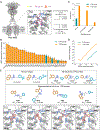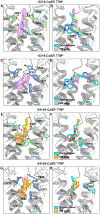Large library docking identifies positive allosteric modulators of the calcium-sensing receptor
- PMID: 39298584
- PMCID: PMC11629082
- DOI: 10.1126/science.ado1868
Large library docking identifies positive allosteric modulators of the calcium-sensing receptor
Abstract
Positive allosteric modulator (PAM) drugs enhance the activation of the calcium-sensing receptor (CaSR) and suppress parathyroid hormone (PTH) secretion. Unfortunately, these hyperparathyroidism-treating drugs can induce hypocalcemia and arrhythmias. Seeking improved modulators, we docked libraries of 2.7 million and 1.2 billion molecules against the CaSR structure. The billion-molecule docking found PAMs with a 2.7-fold higher hit rate than the million-molecule library, with hits up to 37-fold more potent. Structure-based optimization led to nanomolar leads. In ex vivo organ assays, one of these PAMs was 100-fold more potent than the standard of care, cinacalcet, and reduced serum PTH levels in mice without the hypocalcemia typical of CaSR drugs. As determined from cryo-electron microscopy structures, the PAMs identified here promote CaSR conformations that more closely resemble the activated state than those induced by the established drugs.
Conflict of interest statement
Figures





Update of
-
Small vs. Large Library Docking for Positive Allosteric Modulators of the Calcium Sensing Receptor.bioRxiv [Preprint]. 2024 Mar 6:2023.12.27.573448. doi: 10.1101/2023.12.27.573448. bioRxiv. 2024. Update in: Science. 2024 Sep 20;385(6715):eado1868. doi: 10.1126/science.ado1868. PMID: 38234749 Free PMC article. Updated. Preprint.
References
Publication types
MeSH terms
Substances
Grants and funding
LinkOut - more resources
Full Text Sources
Research Materials
Miscellaneous

